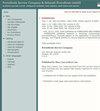Preparation of monoclonal antibodies against human telomerase.
引用次数: 4
Abstract
Telomerase, a ribonucleoprotein enzyme that extends telomeres of eukaryotic chromosomes, consists of the catalytic protein submit telomerase reverse transcriptase (TERT) and a telomerase RNA subunit. Nearly 85% of human tumors have tested positive for high telomerase activity. Telomerase activity is very low or not present in normal cells, whereas it is up-regulated in immortalized cells. Telomerase, partially purified from the breast tumor cell line MCF-7, was used to immunize Balb/C mice. Monoclonal antibodies (MAbs) were prepared by conventional hybridoma technology and screened by enzyme-linked immunoadsorbent assay (ELISA), followed by a polymerase chain reaction (PCR) based telomeric amplification repeat protocol (TRAP) assay to detect binding to or inhibition of telomerase activity. Reactive MAbs were found to be of IgM type by mu specific ELISA. Two MAbs were characterized, one that neutralizes telomerase activity in TRAP assay and the other non-neutralizing. In Western blotting, crude telomerase extract and HIV-1 virus lysate (control) were blotted on nitrocellulose membranes and the strips were treated with both MAbs and a nonrelated HIV polymerase-specific MAb, also IgM type. A band of approx. 65-kDa was detected in extracts of 293 cells with both the MAbs, but no reaction occurred with the HIV polymerase-specific MAb used as control. Similarly, when HIV-1 virus lysate strips were treated with HIV polymerase-specific MAb, a 65-kDa band was detected and no band was observed with either of the hybridoma supernatants. These antibodies may be useful for studying regulatory mechanism of telomerase and inhibition of its activity in vitro and in vivo.人端粒酶单克隆抗体的制备。
端粒酶是一种延伸真核生物染色体端粒的核糖核蛋白酶,由端粒酶逆转录酶(TERT)催化蛋白和端粒酶RNA亚基组成。近85%的人类肿瘤检测出端粒酶活性高。端粒酶活性在正常细胞中非常低或不存在,而在永生化细胞中则上调。端粒酶部分纯化自乳腺肿瘤细胞系MCF-7,用于免疫Balb/C小鼠。采用常规杂杂瘤技术制备单克隆抗体(mab),采用酶联免疫吸附试验(ELISA)筛选单克隆抗体,采用基于聚合酶链反应(PCR)的端粒扩增重复协议(TRAP)检测单克隆抗体对端粒酶活性的结合或抑制作用。ELISA检测发现反应性单克隆抗体为IgM型。鉴定了两种单克隆抗体,一种在TRAP检测中中和端粒酶活性,另一种非中和。在Western blotting中,端粒酶粗提取物和HIV-1病毒裂解液(对照)在硝化纤维素膜上进行印迹,并用单克隆抗体和非相关的HIV聚合酶特异性单克隆抗体(也是IgM型)处理。一个大约的范围。这两种单抗在293细胞提取物中检测到65-kDa,但与HIV聚合酶特异性单抗作为对照未发生反应。同样,当HIV-1病毒裂解液条用HIV聚合酶特异性MAb处理时,检测到65-kDa条带,而在杂交瘤上清液中均未观察到条带。这些抗体对研究端粒酶的调控机制和体内外抑制端粒酶活性具有重要意义。
本文章由计算机程序翻译,如有差异,请以英文原文为准。
求助全文
约1分钟内获得全文
求助全文

 求助内容:
求助内容: 应助结果提醒方式:
应助结果提醒方式:


